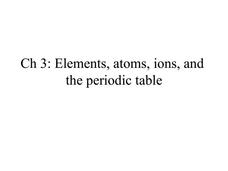Curated OER
2002 U.S. National Chemistry Olympiad National Exam - Part I
As to be expected from the American Chemical Society Olympiad Examinations Task Force, this 60-question test tops the charts in terms of excellence. It consists entirely of multiple choice questions designed to assess a year's worth of...
Curated OER
2009 U.S. National Chemistry Olympiad National Exam - Part I
The 2009 version of the first part of a national chemistry competition is posted for your use with olympiad hopefuls. Test takers deal with 60 multiple choice questions covering an entire year of chemistry curriculum. Use this to...
Curated OER
2000 U.S. National Chemistry Olympiad Local Section Exam
This 60-question comprehensive exam was designed to determine who would go on to compete in the 2000 US National Chemistry Olympiad. Hopefuls answer multiple choice questions regarding all chemistry topics taught in the first year...
Curated OER
The Photoelectric Effect in Photocells
Illuminate your physics class with this examination of a photovoltaic cell. Teach the structure and operation of the device using a diagram. Then make a human-powered, larger-than-life sized model of a PV cell. Learners become electrons...
Kenan Fellows
What Element Would You Be?
Primo Levi wrote a collection of short stories comparing his life from Italy to Auschwitz to elements in the periodic table. Pupils read an excerpt from his book and research the characteristics of various elements. Then, they make a...
Science Geek
Periodic Trends
If your pupils think Um is the element of confusion, this presentation on period trends can only help. It covers the patterns for atomic radii, ionization energy, and electronegativity across a period and down a group.
It's About Time
Atoms with More Than One Electron
Provide young chemists with the ability to manipulate atoms and predict their results, in this sixth lesson. Pupils analyze energy patterns as they predict the amount of energy required to remove electrons from atoms. They compare trends...
Curated OER
Summary of Periodic Trends
This concise collection of images speaks volumes about the trends in the periodic table of elements. Different versions of the periodic table are displayed demonstrating different trends. Teachers' notes are included to assist your...
Curated OER
Elements, Atoms, Ions, and the Periodic Table
This PowerPoint provides a complete recap of all the information needed for a unit on elements and the periodic table. The seventy slides cover the basic notation of elements, energy levels and ionization energies. The trends in the...
Curated OER
Periodic Trends
Chemists compare the electronegativity, ionization energy, electron affinity, and ionic radius of different elements. This worksheet is composed of 11 multiple choice questions, and 8 written explanations. Critical thinking skills are...
Curated OER
The Periodic Table
A huge collection of slides introduces chemistry learners to the periodic table of elements, electron configuration, and electronegativity. It opens with the history of today's periodic table, and then details the arrangement. After...
Curated OER
Periodic Trends
Thorough explanations of the trends in the periodic table of elements make up the majority of this handout. Atomic and ionic size, ionization energy, electron affinity, and electronegativity are presented before giving chemistry...
Curated OER
What do Atoms Look Like?
In this atoms worksheet, learners complete 58 questions about the atomic radius of atoms, the ionization energy, the valence electrons, metals, non-metals and semi-metals and the families of elements.
Curated OER
What do Atoms Look Like?
In this atom activity, high schoolers complete 60 questions about the trends in atoms such as ionization energy and atomic radius, about valence electrons, about the families of elements, about metals, non-metals and semi-metals, about...
Curated OER
How Do Atoms Stick Together?
In this chemical bonding activity, learners answer 10 questions about ionic bonding, covalent bonding, metallic bonding, Lewis structures, and intermolecular forces.
Curated OER
Trends in the Periodic Table
In this trends in the periodic table instructional activity, high schoolers plot the ionization energy vs. atomic number and they plot atomic radius vs. atomic number of the first 20 elements. Students analyze their graphs and answer...
Curated OER
The Properties of Metals
In this properties of metals worksheet, students read about the history of metal use and their properties. Students read about metallic bonding and answer three questions about bonding in metals.
Curated OER
Main Group: Properties and Reactivity
In this main group worksheet, students apply their knowledge of the organization of the periodic table to correctly answer 30 multiple choice questions. Students relate information about the properties of the different groups and their...
Curated OER
Atomic Trend Practice
In this atomic trend worksheet, students answer questions about trends in the periodic table such as ionization energy, atomic radii and electronegativity. They are given tables of elements and ions and they must identify which ones have...
Curated OER
Atomic Electron Configuration and Chemical Periodicity
In this electron configuration and periodicity worksheet, students answer fifteen questions about periodic trends and they analyze orbital diagrams indicating location of electrons.
Curated OER
Periodic Table Trends
In this periodic trends worksheet, students solve ten problems related to elements in the periodic table. Students write electron configurations for atoms and they compare elements and their periodic trends.
Curated OER
Periodic Trends
In this periodic trends worksheet, students determine the trends of electronegativity in the periodic table. Students compare electronegativity and ionization energy. This worksheet has 6 problems to solve.
Curated OER
Properties of the Elements
In this elements worksheet, students compare the properties of elements in the periodic table such as their atomic radii, valence electrons and ionization energy.
Curated OER
Ionization Energies in Group I and Period 2
In this electron arrangement worksheet, students complete 2 graphic organizers by determining the proton number of given elements from their first ionization energy. Students plot graphs of first ionization energy against the proton number.

























